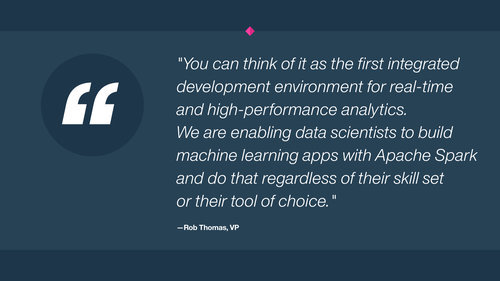
Data Science Experience
IBM Data Science Experience is a one-stop-platform for data scientists to learn about new tools and trends, create valuable insights based on open source tools, and collaborate within their teams and the broader data science community.
Role : UX Researcher & Designer
November 2016-Current
Lead design research efforts for product, leveraging data to influence product design strategy. Work directly with offering management and design on both creation and validation efforts. Create user flows and process diagrams, produce annotated wireframes, validate designs through user testing and customer engagement opportunities, and ALWAYS produce output.
I help my team learn by making things.
I am not a data scientist....so when I was dropped into the DSX product, I had a lot to learn. After several weeks of meetings, I noticed there was a major issue with the design team; none of us had any comprehensive understanding of what our product solved, or where it fell within our platform. I got ahold of everything I could, and led a quick status meeting to ensure design all had a base understanding. Please find some of that content below.
Data Science 101
Data science is a way to make new discoveries. It’s the process of analyzing data to gain knowledge.
Businesses are gaining data faster than knowledge can be extracted. In order to make the best discoveries, they need to be using all relevant data, not just what they collected. Data Science emerged from the intersection of social science and statistics, information and computer science, and design.
Tools of the trade: R, Python, SQL, Statistics, Machine Learning, Calculus, Algebra, Data Visualization, etc.
Why DSX Was Created
DSX was created as a result of two major needs in the data science space:
1. The need for collaboration, and
2. The need to do productive data science work.
DSX helps data scientists gain a competitive advantage by closing the gap between data collection and actionable insights. Its’ integrated suite of tools and environment allows users to leverage open source and emerging techniques, and ultimately brings together storage and collaboration mechanisms to surface data insights.
Where DSX Fits Within Platform
DSX is part of a larger platform offering, called Watson Data Platform, which encompasses a series of product experiences that supplement one another. DSX represents the spearhead for the overall strategy, which is a shift from Products to Platforms.
As the most visible offering in Watson Data Platform, DSX is leading the portfolio in terms of vision, best-practices and opportunities to capture the client’s hearts…ie cross-sell to other offerings. Most of the other offerings have to do with project management, helping users store, manage and transport data, but DSX fulfills the ultimate end-goal of allowing users to act on that data.
I facilitate workshops
My role on the team has shifted between User Researcher and UX Designer. In other words, I assisted with providing a point of discussion to establish the relationship between design and the rest of the product team. The earliest and most important things we accomplished, were airing misconceptions, creating a standard, defining terminology, and setting expectations. We did this through the use of Design Thinking Workshops, in which we had representatives from all four of product divisions: Content, Development, Offering Management, and Design
I create flows
I begin most issues, by creating user flows to gain an understanding of the different paths a user might encounter. When I begin work on a product, I create site-maps and decision trees that I try and validate as I learn more. Flows are also helpful when designing solutions or features, because as much as we might not like it, edge cases do exist!
I talk to users
As much as possible, I try to actually get in front of our users. Visually seeing frustration on a user's face is a very powerful motivator. As a result of partnership that emerged between IBM and a boot camp-accelerator program called Galvanize, we were able to observe and interact with hundreds of users, who were using DSX for the first time AND applying it to real-world problems.
I make things
As a UX Designer for DSX, I created a lot of wireframes. Because we worked with Github, the design team was very collaborative and we often had multiple issues assigned to each other at any given time. It was very easy to get feedback on work, and iteration was key to meeting deliverables.
I integrate research.
My first goal when coming onto DSX, was to create an iterative user-testing plan. Ultimately, we needed to show the value of research to the product team, so that we would have buy-in from stakeholders and easier access to users. The first user-testing we conducted was more of usability testing, and through this testing it was revealed that the problem we were solving for was not even on the table for these users, there was an even bigger issue to solve for. Because of the value this research added, we started to gain credibility in the eyes of our Stakeholders.





















